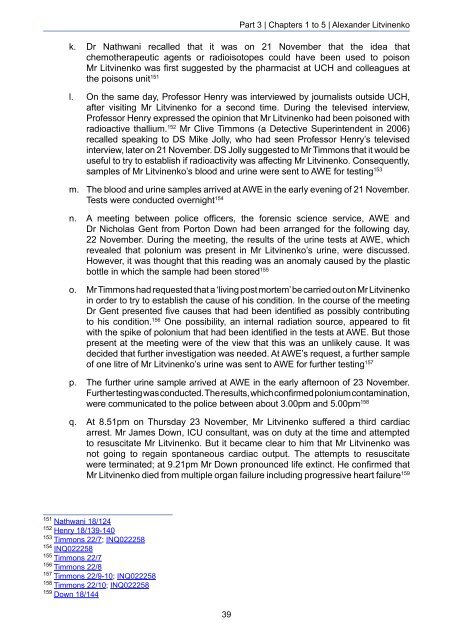The Litvinenko Inquiry
JIEp7Zyr
JIEp7Zyr
Create successful ePaper yourself
Turn your PDF publications into a flip-book with our unique Google optimized e-Paper software.
Part 3 | Chapters 1 to 5 | Alexander <strong>Litvinenko</strong><br />
k. Dr Nathwani recalled that it was on 21 November that the idea that<br />
chemotherapeutic agents or radioisotopes could have been used to poison<br />
Mr <strong>Litvinenko</strong> was first suggested by the pharmacist at UCH and colleagues at<br />
the poisons unit 151<br />
l. On the same day, Professor Henry was interviewed by journalists outside UCH,<br />
after visiting Mr <strong>Litvinenko</strong> for a second time. During the televised interview,<br />
Professor Henry expressed the opinion that Mr <strong>Litvinenko</strong> had been poisoned with<br />
radioactive thallium. 152 Mr Clive Timmons (a Detective Superintendent in 2006)<br />
recalled speaking to DS Mike Jolly, who had seen Professor Henry’s televised<br />
interview, later on 21 November. DS Jolly suggested to Mr Timmons that it would be<br />
useful to try to establish if radioactivity was affecting Mr <strong>Litvinenko</strong>. Consequently,<br />
samples of Mr <strong>Litvinenko</strong>’s blood and urine were sent to AWE for testing 153<br />
m. <strong>The</strong> blood and urine samples arrived at AWE in the early evening of 21 November.<br />
Tests were conducted overnight 154<br />
n. A meeting between police officers, the forensic science service, AWE and<br />
Dr Nicholas Gent from Porton Down had been arranged for the following day,<br />
22 November. During the meeting, the results of the urine tests at AWE, which<br />
revealed that polonium was present in Mr <strong>Litvinenko</strong>’s urine, were discussed.<br />
However, it was thought that this reading was an anomaly caused by the plastic<br />
bottle in which the sample had been stored 155<br />
o. Mr Timmons had requested that a ‘living post mortem’ be carried out on Mr <strong>Litvinenko</strong><br />
in order to try to establish the cause of his condition. In the course of the meeting<br />
Dr Gent presented five causes that had been identified as possibly contributing<br />
to his condition. 156 One possibility, an internal radiation source, appeared to fit<br />
with the spike of polonium that had been identified in the tests at AWE. But those<br />
present at the meeting were of the view that this was an unlikely cause. It was<br />
decided that further investigation was needed. At AWE’s request, a further sample<br />
of one litre of Mr <strong>Litvinenko</strong>’s urine was sent to AWE for further testing 157<br />
p. <strong>The</strong> further urine sample arrived at AWE in the early afternoon of 23 November.<br />
Further testing was conducted. <strong>The</strong> results, which confirmed polonium contamination,<br />
were communicated to the police between about 3.00pm and 5.00pm 158<br />
q. At 8.51pm on Thursday 23 November, Mr <strong>Litvinenko</strong> suffered a third cardiac<br />
arrest. Mr James Down, ICU consultant, was on duty at the time and attempted<br />
to resuscitate Mr <strong>Litvinenko</strong>. But it became clear to him that Mr <strong>Litvinenko</strong> was<br />
not going to regain spontaneous cardiac output. <strong>The</strong> attempts to resuscitate<br />
were terminated; at 9.21pm Mr Down pronounced life extinct. He confirmed that<br />
Mr <strong>Litvinenko</strong> died from multiple organ failure including progressive heart failure 159<br />
151<br />
Nathwani 18/124<br />
152<br />
Henry 18/139-140<br />
153<br />
Timmons 22/7; INQ022258<br />
154<br />
INQ022258<br />
155<br />
Timmons 22/7<br />
156<br />
Timmons 22/8<br />
157<br />
Timmons 22/9-10; INQ022258<br />
158<br />
Timmons 22/10; INQ022258<br />
159<br />
Down 18/144<br />
39


